Physical Address
304 North Cardinal St.
Dorchester Center, MA 02124
Immunohistochemistry (IHC), or immunocytochemistry (ICC), is a laboratory technique used to detect specific antigens (i.e., proteins) in tissues or cells based on antigen-antibody recognition; it seeks to exploit the specificity provided by the binding of an antibody with its target antigen at the light-microscopy level. IHC has a long history that dates back more than 70 years when Coons first developed an immunofluorescence technique to detect matching antigens in frozen tissue sections. However, only since the early 1990s has the method found general application in surgical pathology. A series of technical developments eventually led to the wide range of IHC applications in use today. The enzymatic label known as horseradish peroxidase (HRP), developed by Avrameas and by Nakane and Pierce, allowed visualization of the labeled antibody by light microscopy in the presence of a suitable chromogenic substrate system. At Oxford, Taylor and Burns developed the first successful demonstration of antigens in routinely processed, formalin-fixed, paraffin-embedded (FFPE) tissues. A critical issue in the early development of immunoperoxidase techniques was related to the need to achieve greater sensitivity, because greater sensitivity would facilitate testing of FFPE tissues where many protein targets were damaged or masked due to harsh fixation. Methods evolved from a simple, one-step, direct-conjugate method to multistep detection techniques such as the peroxidase-antiperoxidase (PAP), avidin-biotin complex (ABC), and biotin-streptavidin (B-SA) methods. This evolution eventually led to amplification methods, such as tyramide and highly sensitive polymer-based labeling systems. , We describe these methods in detail later in this chapter.
As the IHC method has evolved, its role in diagnostic pathology has expanded such that the use of one or more IHC “tests” is routine in surgical pathology, especially with respect to tumor diagnosis and classification. Furthermore, IHC has been adapted to the identification and demonstration of both prognostic and predictive markers (i.e., biomarkers), with corresponding requirements for semi-quantitative reporting of results. The widespread use of IHC and the demands for comparison of qualitative and semi-quantitative findings among an increasing number of laboratories have resulted in a growing focus on reproducibility and a new emphasis on standardization. Standardization serves as an underlying theme of this chapter and is discussed in detail in the “Quality Control and Standardization” section.
Another dramatic change in the last several years is the increasing adoption of automated platforms with major implications with respect to the choice of reagents, protocols, and controls. As a result, parts of this chapter have been revised to accommodate the majority of laboratories that perform all, or most, of their IHC testing on automated platforms. Sufficient basic methodology has been retained to allow for intelligent and effective use of manual methods where necessary.
The development of the technique known as hybridoma facilitated the development and exponential growth of IHC and the manufacture of abundant, highly specific monoclonal antibodies, and many of which found early application in testing of tissues. The critical significance of rendering the IHC technique suitable for routine paraffin sections was illustrated in 1974 by Taylor and Burns, who showed that it was possible to demonstrate at least some antigens in routinely processed tissue. , , These initial studies led to serious attempts by pathologists to improve the ability to perform IHC testing on FFPE sections, , therefore eliminating the requirement for frozen tissue. Although great effort has been expended in the search for alternative fixatives (formalin substitutes) to preserve antigenicity without compromising preservation of morphologic features, no ideal fixative has been found to date. Larsson even states that “An ideal immunocytochemical fixative applicable to all antigens may never be found.” As for the near future, we agree. In addition, any new fixative must show preservation of morphologic features comparable with FFPE specimens to avoid problems in interpretation and diagnosis.
Enzyme digestion was introduced by Huang as a pretreatment to IHC testing to “unmask” some antigens that had been altered by formalin fixation. However, the enzyme digestion method, although widely applied, did not improve immunoreactivity (IR) for many antigens, a subject well-reviewed by Leong and colleagues. One drawback of enzyme digestion is that it is difficult to control, as shown in external proficiency studies, which is discussed later with reference to antigen retrieval (AR). These difficulties in standardization provided a powerful incentive for the development of a more powerful, more widely applicable method to enhance IHC testing of routine FFPE tissue sections. The AR technique—also known as heat-induced epitope retrieval (HIER), based on a series of biochemical studies by Fraenkel-Conrat and coworkers —was developed by Shi and associates in 1991. The AR technique is a simple method that involves heating routinely processed paraffin sections at high temperature (e.g., in a microwave oven or other suitable heating device) before IHC testing procedures. An alternative method that does not use heating was developed for celloidin-embedded tissues. The intensity of IR for many antigens was increased dramatically after AR pretreatment. Subsequently, various modifications of the AR technique have been described that serve to validate the feasibility of AR-IHC and to expand its use in molecular morphology. , , At the same time, some basic questions and practical issues were raised with respect to standardization , , , , ; these questions are discussed in more detail in the “Antigen Retrieval” section.
It is the authors’ view that there is no immediate prospect of replacing formalin in routine surgical pathology. Even if consensus were to be reached regarding a superior fixative, the logistics of converting all laboratories nationwide, yet alone worldwide, and requiring extensive re-validation of each antibody tested, would be formidable. Formalin is thus what we must work with for the foreseeable future. For this reason, this chapter focuses on IHC as applied to FFPE tissue sections for diagnostic pathology. In addition to basic principles and practical technical issues, the limitations and pitfalls of IHC are discussed with the intention of providing food for thought in the further development of IHC, particularly with respect to standardization and, ultimately, quantitative IHC applications.
The principles and practices described are derived from the long experience of the authors and are supported by certain core reference materials, particularly the Revised Guidelines of the Clinical and Laboratory Standards Institute ; the published materials of two major proficiency testing programs, United Kingdom (UK) National External Quality Assessment (NEQAS) and NordiQC ; and select ad-hoc committees have issued recommendations in areas of difficulty.
Surgical pathologists have long recognized their fallibility, although they have not always publicized it. , They have, however, sought more certain means of validating morphologic judgments. A variety of “special” stains were developed to facilitate cell recognition and diagnosis, and most of these early stains were based on chemical reactions of cell and tissue components in frozen sections (histochemistry). In certain circumstances, these histochemical stains proved to be of critical value in specific cell identification. More often, they served merely to highlight or emphasize cellular or histologic features that supported a particular interpretation without providing truly specific confirmation. When the new field of IHC was created by combining immunology with histochemistry, the result was an enormous variety of truly specific “stains,” potentially as many as there are specific antibodies—literally thousands. IHC has been the subject of thousands of papers, and the vast majority of current publications in anatomic pathology incorporate some IHC findings.
The aims of IHC are akin to those of histochemistry. Indeed, IHC builds on the foundations of histochemistry, but greatly extends the variety of cells and tissue components that can be demonstrated specifically within tissue sections or other types of specimens (e.g., cytology smears and cell blocks). As emphasized by pioneers in this field of functional morphology, “the object of all staining is to recognize micro-chemically the existence and distribution of substances which we have been made aware of macrochemically.” The basic critical principle of IHC, as with any other special staining method, is a sharp visual localization of target components in the cells and tissue based on a satisfactory signal-to-noise ratio. Amplifying the signal while reducing nonspecific background (noise) has been a major strategy to achieve a satisfactory result that is useful in daily practice.
In the past 40 years, advances in IHC have provided a feasible approach to performing testing on routinely processed FFPE specimens, such that this method is now routine for the performance of IHC in surgical pathology laboratories worldwide. Recently, demands for improved reproducibility and quantification have led to a growing recognition that IHC has the potential to be more than just a “special stain.” If properly controlled in all aspects of its performance, IHC can provide a tissue-based immunoassay with the reproducibility and quantitative characteristics of an enzyme-linked immunosorbent assay (ELISA) test, which not only detects the presence of an analyte, a protein, or antigen in relation to tissue and cell architecture, but also provides an accurate and reliable measure of its relative or real amount. This critical topic is discussed further in the “Quality Control and Standardization” section. For this reason, the authors now recommend that these critically important “special stains” be referred to as “tests” or “assays,” and not stains. The pathology community must upgrade the terminology for these invaluable laboratory tests especially in the eyes of clinicians, patients, and, most importantly, for those who provide reimbursement for performing this testing.
An antibody is a molecule that has the property of combining specifically with a second molecule, termed the antigen (i.e., protein). Furthermore, the production of antibody by an animal is induced specifically by the presence of the corresponding antigen, which constitutes the basic immune response. Antigen-antibody recognition is based on the three-dimensional (3D) structure of protein or some other antigen, which may be compromised by formalin-induced modification of protein conformation (“masking”) but is restored in part by AR. We discuss this process later in this chapter.
Antibodies are immunoglobulin (Ig) molecules that consist of two basic units: a pair of light chains, either a kappa or a lambda pair, and a pair of heavy chains—gamma, alpha, mu, delta, or epsilon. An antigen is any molecule sufficiently complex such that it maintains a relatively rigid 3D profile and is foreign to the animal into which it is introduced. Good antigens are proteins and carbohydrates that possess a unique 3D charge-shape profile. In fact, such molecules may bear more than one unique 3D structure capable of inducing antibody formation ( Fig. 1.1 ). Each of these individual sites on a molecule may be termed an antigenic determinant or epitope— the exact site on the molecule with which the antibody binds. For a protein, the term epitope corresponds to a cluster of amino acid residues that binds specifically to the paratope of an antibody. Although it is part of the protein, an epitope cannot be recognized independently of its paratope partner. Antigenic determinants (epitopes) may be classified as continuous or discontinuous; the former are composed of a continuum of residues in a polypeptide chain, whereas the latter consist of residues from different parts of a polypeptide chain brought together by the folding of the protein conformation. This interesting issue may reflect the variable influence of formalin fixation on “antigenicity” and variations in the effectiveness of AR.
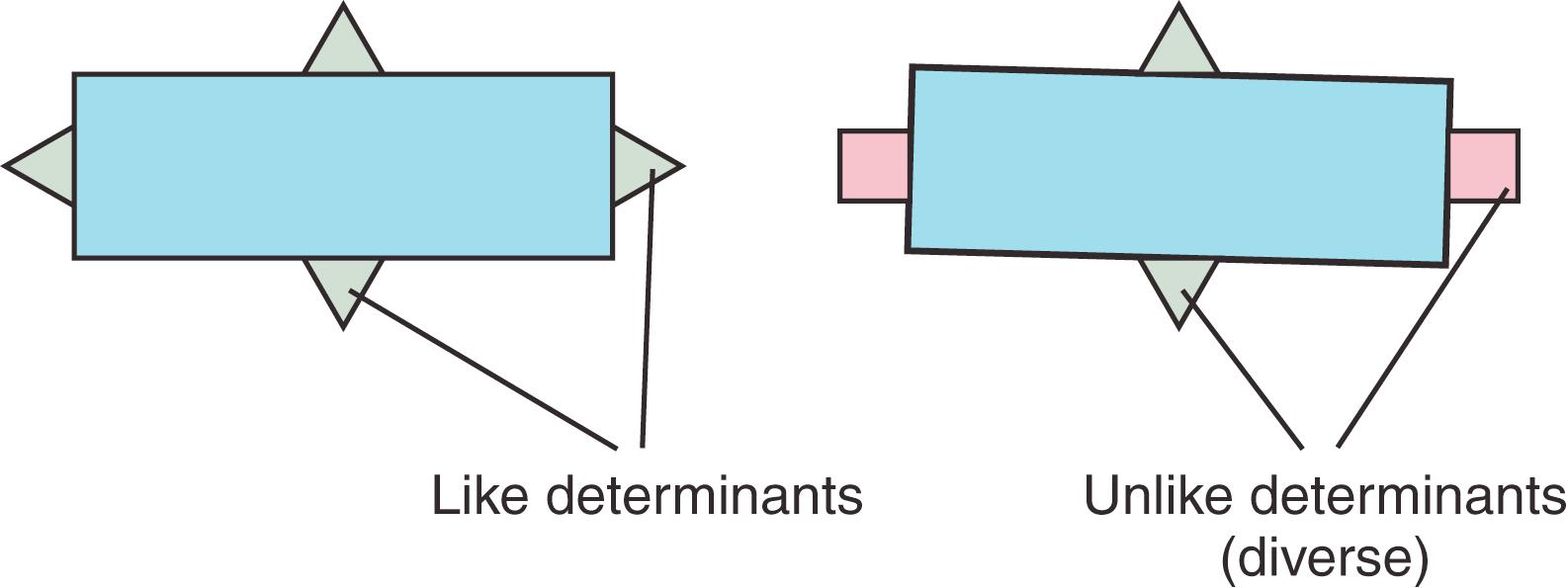
Antibody molecules are proteins; thus, any rigid part of an antibody molecule may itself serve as the antigenic determinant to induce an antibody. IHC techniques exploit the fact that Ig molecules can serve both as antibodies, binding specifically to tissue antigens, and as antigens, providing antigenic determinants to which secondary antibodies may bind ( Fig. 1.2 ).
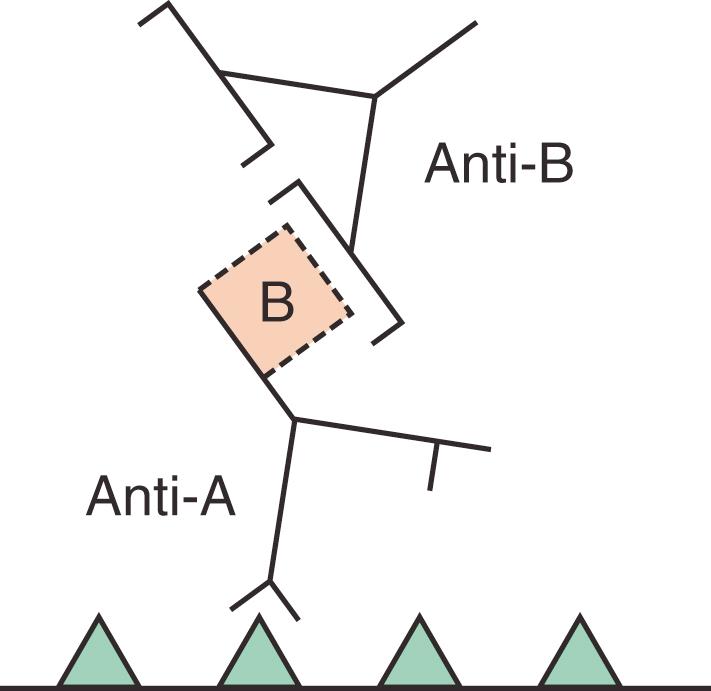
Evaluation of an antibody for use in IHC is based on two main points: the sensitivity and the specificity of the antibody-antigen reaction. The development of the hybridoma technique provided an almost limitless source of highly specific antibodies. However, monoclonal antibodies do not guarantee absolute antigen specificity, because different antigens may share similar or cross-reactive epitopes. Nonetheless, the “practical” specificity reflected by IHC is excellent for most monoclonal antibodies. In contrast, a polyclonal antibody is an antiserum that contains many different molecular species of antibody with varying specificities against different parts of the antigen, or antigenic determinants, used to immunize the animal. It is important to remember that polyclonal antibodies may also include varying amounts of antibodies to a whole range of other antigens, including bacteria and viruses that the immunized animal encountered before its use as a source of antibody. As a result, polyclonal antibodies often give more nonspecific background in tissue section than is encountered when using monoclonal antibodies. By the same token, however, the presence of a mixture of different antibodies against an antigen may on occasion confer an advantage to the use of polyclonal antibodies in the detection of certain hard-to-detect antigens in fixed tissues. For these reasons, the use of highly purified antigen preparations to produce high-affinity conventional polyclonal antibodies (antisera), which are then subjected to multiple absorption procedures to maximize specificity, is of value for certain applications. It is important to note that immunodiffusion and ELISA assays typically used by manufacturers in the assessment of the specificity of antisera often fail to detect trace, unwanted antibody specificities that may become apparent only when the antiserum is applied to tissue sections that contain many different antigens.
Comparison of sensitivity and specificity between polyclonal and monoclonal antibodies indicates that polyclonal antibody may be more sensitive but is often less specific than monoclonal antibody. The reason may be that a polyclonal antibody, a composite of many antibodies, may recognize several different binding sites (epitopes) on a single protein (antigen), whereas a monoclonal antibody recognizes only a single epitope. Sophisticated amplification techniques, coupled with the use of the AR technique, have reduced the practical importance of this distinction. Although the specificity of a monoclonal antibody is, as noted, not absolute because of cross-reactivity with non-target molecules, most commercially available monoclonal antibodies are highly reliable for IHC. Many monoclonal antibodies in current use are derived from murine clones. More recently, a number of rabbit-derived monoclonal antibodies have appeared on the market, and manufacturers may sell both, or one or the other, for a single antigen. Some rabbit monoclonal antibodies appear to offer advantages over murine clones for detection of certain antigens by IHC, but this phenomenon may be more a function of differences in relative immunogenicity of different proteins in the two species, rather than an absolute superiority of rabbit monoclonal antibodies over murine monoclonal antibodies, or vice versa. In addition, recombinant DNA techniques have been used to develop antibodies that may demonstrate improved practical specificity following stringent affinity purification exemplified by the use of recombinant protein epitope signature tags (PrESTs).
Selection of the best antibody is described briefly in the following paragraphs with additional detail in the sections on detection systems and quality control (QC) and standardization. It must be emphasized that the ultimate specificity control for both monoclonal and polyclonal antibodies should be the observation of the expected pattern of IR in control tissue and test sections and a corresponding lack of unexpected or inexplicable reactions (see the “Quality Control and Standardization” section). Correlation of the IR of a new antibody with the literature for antigen distribution is strongly encouraged. Comparison of the IR of the test antibody with that of a second antibody known to bind to the same antigen but to a different epitope is also valuable in establishing useful specificity, a process that may be accomplished by comparing reagents from different manufacturers, with careful attention to clone designation in the package insert. Lastly, websites such as www.proteinatlas.org offer a wealth of information with respect to the patterns of IR of numerous antibodies and clones on normal and abnormal (cancer) tissues. Such information is useful as a guide, but it is important to remember it will not necessarily reflect the findings of another laboratory with differing fixation methods and tissue processing protocols.
Two aspects of the blocking of background “noise” in tissues may be attributable either to nonspecific antibody binding or to the presence of endogenous enzymes. Nonspecific antibody binding is generally more of a problem with polyclonal antibodies, because multiple unwanted antibodies may exist in the antiserum. The greater the optimal working dilution, the less significant is the problem. Another form of nonspecific binding may result from the fact that antibodies are highly charged molecules that may bind nonspecifically to tissue components that bear reciprocal charges, such as collagen. Such nonspecific binding may lead to the localization of either the primary antibody or the labeled moiety, producing false-positive background of collagen and other tissue components of a degree sufficient to obscure specific IR. Pre-incubation with normal serum usually reduces these kinds of nonspecific binding. In theory, proteins in the normal serum occupy the charged sites within the tissue section, excluding or at least reducing nonspecific attachment of antibodies added subsequently. In practice, it is customary to use normal serum or purified Ig from the same species as the secondary antibody (in conjugate methods), because this normal serum neither interferes with nor participates in the immunologic reactions that occur as part of the IHC procedure.
Blocking endogenous enzyme activity is also important. The degree of susceptibility of an enzyme to denaturation and inactivation during fixation varies. Some enzymes, such as peroxidase, are preserved in both paraffin and frozen sections; others, such as alkaline phosphatase, are completely inactivated by routine fixation and paraffin-embedding procedures. Any residual activity of these endogenous enzymes must be abolished during IHC testing to avoid false-positive reactions when using the same or similar enzymes as labels. Peroxidase activity is present in a number of normal and neoplastic cells that include erythrocytes, neutrophils, eosinophils, and hepatocytes. When performing an IHC test on tissue rich in blood cells, such as bone marrow, it is recommended that a peroxidase-blocking step be used coupled with a substrate control slide (i.e., a section treated only with the hydrogen peroxide–chromogen mixture to visualize the extent of endogenous peroxidase activity). Otherwise, alternative methods such as alkaline phosphatase, glucose oxidase, or immunogold labeling may be used to avoid the possibility of confusion with any endogenous peroxidase activity. To risk stating the obvious, the blocking of endogenous enzymatic activity must be performed before the addition of an enzyme-labeled secondary reagent; otherwise, the enzyme label is also inactivated by the blocking procedure, resulting in a false-negative result. Various approaches have been devised to inhibit peroxidase activity ( Fig. 1.3 ), primarily by using solutions of hydrogen peroxide (H 2 O 2 ). For general purposes, we have obtained satisfactory results with either a 15-minute incubation in a methanol-H 2 O 2 combination or a 5-minute incubation in 3% hydrogen peroxide following re-hydration of the slides. Many manufacturers also include proprietary reagents and protocols that effectively neutralize endogenous peroxidase in both manual and automated methods; in these instances, the recommendations of the manufacturer should be validated for satisfactory performance and then followed strictly.
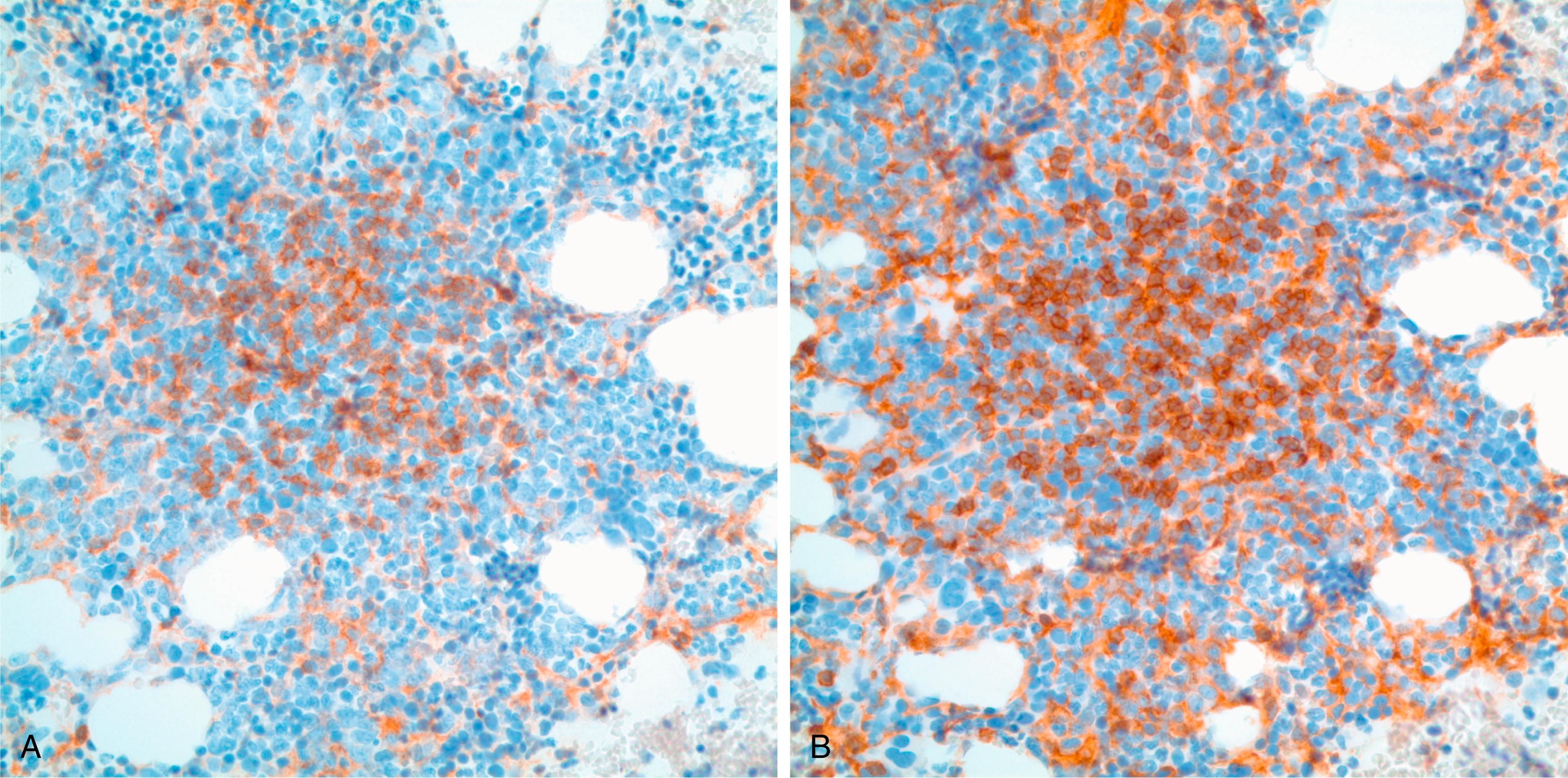
For those who encounter difficulty or wish to explore other approaches, a more detailed discussion follows. Some investigators believe that the methanol-H 2 O 2 approach is too drastic and that it may cause some denaturation of antigen. Straus , advocated the use of a combination of phenylhydrazine, nascent H 2 O 2 (freshly produced by a glucose oxidase–glucose mixture), and sodium azide. Robinson and Dawson adopted a different approach by first developing the endogenous peroxidase with 4-chloro-1-naphthol, giving it a blue-gray color, and then performing the IHC testing procedure with a peroxidase label and diaminobenzidine (DAB), giving a contrasting brown reaction product. Taylor used a similar strategy 30 years ago in the initial reports to describe the feasibility of demonstrating Ig antigens in paraffin sections; α-naphthol pyronine was used for endogenous peroxidase (pink), followed by DAB (brown) for the HRP label. ,
Antibody molecules cannot be seen with the light microscope or even with the electron microscope unless they are labeled or tagged (i.e., flagged) by some method that permits their visualization. Essentially, detection systems attach labels or flags to primary or secondary antibodies to visualize the target antigen-antibody localization in tissue sections. A variety of labels or flags have been used, including fluorescent compounds and active enzymes that can be visualized by their property of inducing the formation of a colored reaction product from a suitable substrate system. Such methods can be adapted to electron microscopy if the products are rendered electron dense by suitable treatment. Alternatively, labels directly visible by electron microscopy may be used, such as gold, ferritin, or virus particles. Fluorescent labels are also making a comeback, based upon a variety of new fluorescent labels and “Q dots” that do not fade. The focus of this chapter is on methods that are interpreted by the usual bright-field microscopy used in diagnostic surgical pathology; other approaches are discussed only briefly.
Another important goal of various detection systems is the enhancement of sensitivity through amplification of the signal, and we discuss this later in the chapter. Although some of the early techniques discussed in the chapter are no longer in use today, they do provide a foundation for the more advanced techniques in use today.
The method of attaching a label to an antibody by chemical means and then directly applying this labeled conjugate to tissue sections ( Fig. 1.4 ) has been used widely in IHC. In preparing a labeled antibody conjugate, the aim is to attach the maximum number of molecules of label to each individual antibody molecule. It is desirable to label 100% of antibody molecules and to render none of them immunologically inactive by the labeling process. The final labeled reagent should not contain free molecules of unlabeled antibody or molecules of antibody linked to an inactivated label.
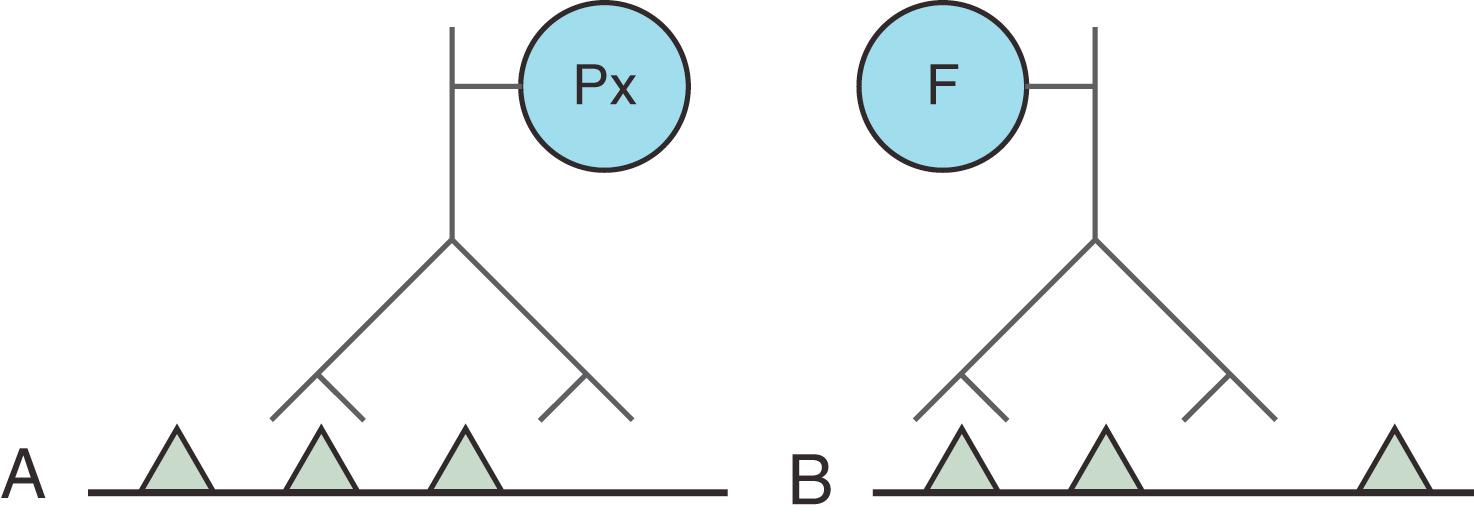
These are exacting requirements that are difficult for individual scientists to meet in-house. However, conjugation methods have improved immensely since the early 1980s, and quality labeled reagents that include peroxidase, glucose oxidase, and alkaline phosphatase labels are available from a number of commercial sources.
The direct-conjugate procedure has the advantages of rapidity and ease of performance. With this method, the purity (i.e., mono-specificity) of the primary antibody or antiserum (polyclonal antibody) is of critical importance. As noted previously, an antiserum contains a range of antibody molecules of differing specificity in addition to the antibody having the desired specificity; all these antibodies are labeled during the conjugation procedure, and any or all may produce reactivity in tissue sections that may lead to erroneous interpretation.
One practical disadvantage of the direct-conjugate procedure is that it is necessary to conjugate each of the appropriate primary antibodies separately to detect different antigens. Also, regarding precious (scarce) antibodies, the direct-conjugate procedure usually demands that the primary antibody be used at a relatively high concentration due to a lack of sensitivity in comparison with indirect and unlabeled antibody methods.
The indirect, or sandwich, conjugate procedure ( Fig. 1.5 ) is a relatively simple modification of the direct-conjugate method. It has the following advantages:
Versatility is increased, because a single conjugated antibody (i.e., secondary) can be used with several different primary antibodies.
The labeling process is applied only to the secondary antibody.
The primary antibody can usually be used at a higher working dilution than in the direct method to achieve successful IR.
The secondary antibody, which is produced against Ig for the species from which the primary antibody is derived, is readily prepared with a high order of specificity and affinity. Many commercial sources are available for labeled secondary reagents, including polymer-based reagents.
The method lends itself to additional specificity controls in that the primary specific antibody may be omitted, or another antibody of irrelevant specificity may be substituted, providing a valuable assessment of the validity of the IR observed.
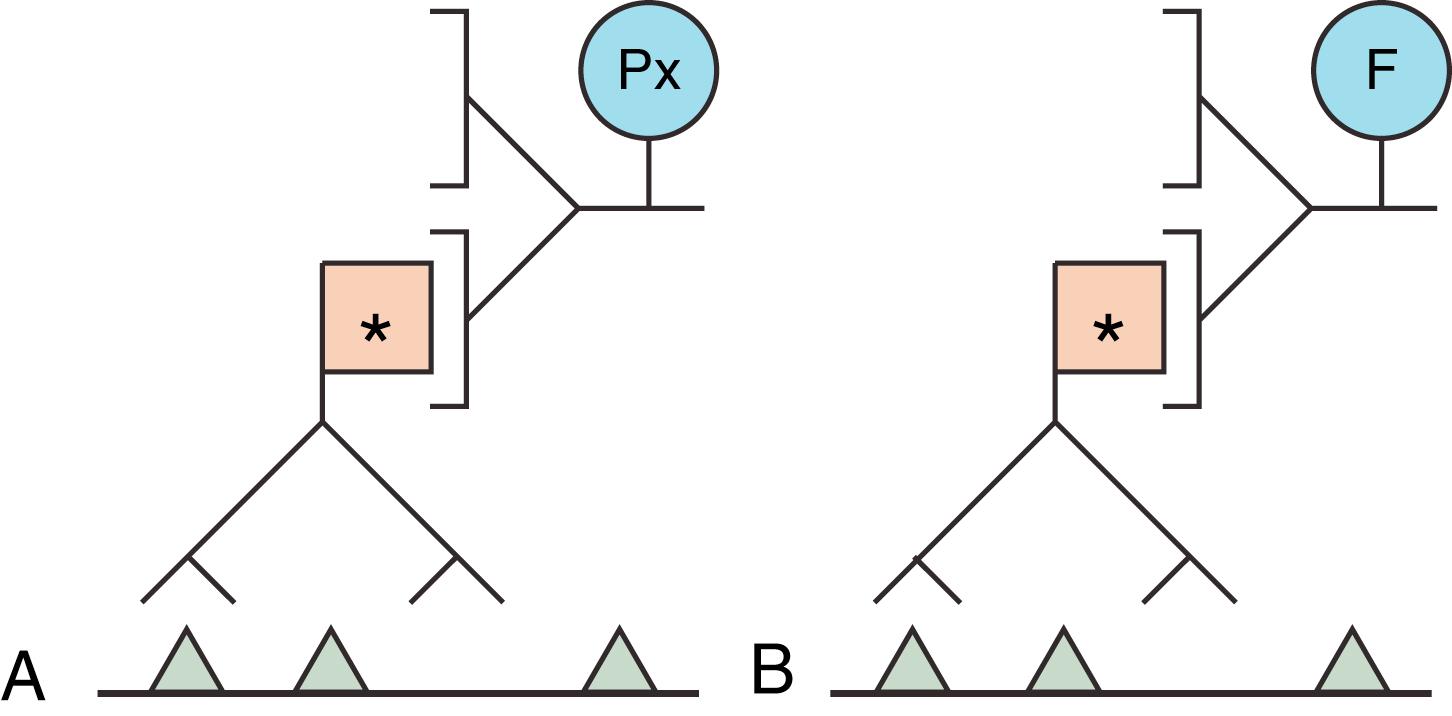
All labeled antibody methods performed by the indirect procedure are analogous in principle; peroxidase and fluorescent indirect-conjugate methods are illustrated in Figs. 1.5A and B , respectively. The primary antibody that has specificity against the antigen of interest (e.g., rabbit anti-triangle) is added to the section, incubated, and then the excess is washed off. The labeled secondary antibody, which has specificity against an antigenic determinant present on the primary rabbit antibody (e.g., swine antibody vs. rabbit Ig), is then added; it serves to label the sites of tissue localization of the primary antibody, which, in turn, is bound to the antigen.
The disadvantages of the chemical conjugation procedure may be entirely avoided by devising techniques whereby the labeled moiety is linked to the antigen solely by immunologic binding. To achieve this end, Mason and colleagues developed a technique that has become known as the enzyme bridge method ( Fig. 1.6 ). This method is rarely used today, but it is included for its value in research applications in which chemical conjugation is undesirable.
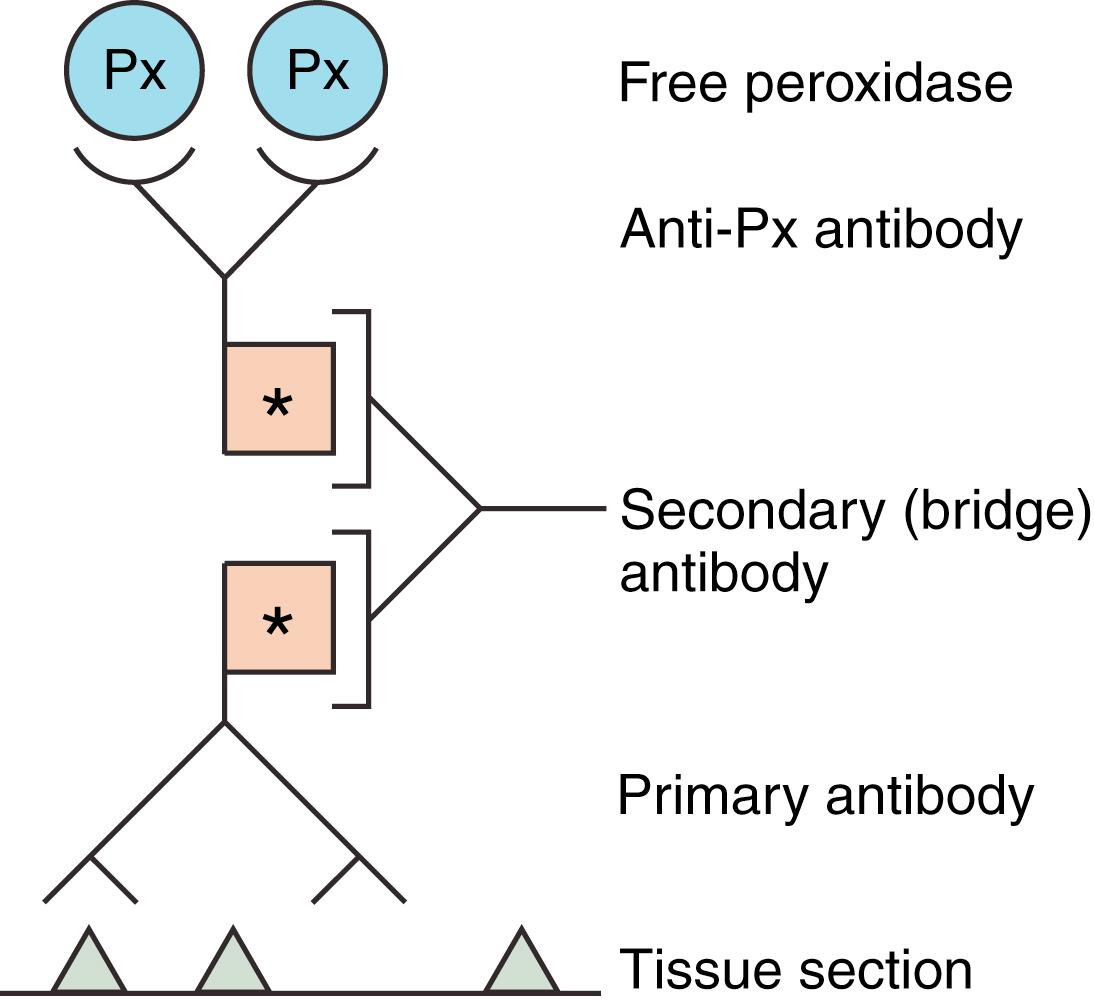
The PAP method ( Fig. 1.7 ) also avoids the problems inherent in chemical conjugation. First used by Sternberger for the detection of anti- Treponema antibodies, the PAP system was reported to have a sensitivity 100-fold to 1000-fold greater than that of comparable conjugate procedures. The principle of the PAP method is similar to that of the enzyme bridge method (see Fig. 1.6 ). The acronym denotes the PAP reagent that consists of antibody against HRP and HRP antigen in the form of a small, stable immune-complex. Available evidence suggests that this immune-complex typically consists of two antibody molecules and three HRP molecules in the configuration shown in Fig. 1.7 . The PAP reagent and the primary antibody must be from the same species or from closely related species with common antigenic determinants, whereas the bridge or linking antibody is derived from a second species and has specificity against the primary antibody (e.g., rabbit anti-triangle) and the Ig incorporated into the PAP complex (e.g., rabbit anti-peroxidase). This method enjoyed extensive use in routinely processed paraffin sections because of its high degree of sensitivity, but it has been replaced by streptavidin- and polymer-based systems.
![Fig. 1.7, Peroxidase-antiperoxidase (PAP) methods. (A) Three-stage PAP method. PAP reagent (dashed box) is a preformed stable immune complex linked to the primary antibody by a “bridging” antibody. The asterisk represents the Fc portion of the antibody molecule. (B) Four-stage PAP method. PAP reagent (dashed box) is a preformed stable immune complex. Primary antibody in this example is murine (mouse immunoglobulin [Ig], as in a monoclonal antibody [M] ); this antibody is followed by a rabbit anti-mouse Ig (R) , a bridge antibody (e.g., swine anti-rabbit Ig), and rabbit PAP. Px, Peroxidase label. Fig. 1.7, Peroxidase-antiperoxidase (PAP) methods. (A) Three-stage PAP method. PAP reagent (dashed box) is a preformed stable immune complex linked to the primary antibody by a “bridging” antibody. The asterisk represents the Fc portion of the antibody molecule. (B) Four-stage PAP method. PAP reagent (dashed box) is a preformed stable immune complex. Primary antibody in this example is murine (mouse immunoglobulin [Ig], as in a monoclonal antibody [M] ); this antibody is followed by a rabbit anti-mouse Ig (R) , a bridge antibody (e.g., swine anti-rabbit Ig), and rabbit PAP. Px, Peroxidase label.](https://storage.googleapis.com/dl.dentistrykey.com/clinical/TechniquesofImmunohistochemistryPrinciplesPitfallsandStandardization/6_3s20B9780323721721000010.jpg)
The biotin-avidin procedure ( Fig. 1.8 ) exploits the high-affinity binding between biotin and avidin. Biotin can be linked chemically to the primary antibody (see Fig. 1.8A ) to produce a biotinylated conjugate that localizes to the sites of antigen within the section. Subsequently, avidin, which is chemically conjugated to HRP, is added; the avidin binds tightly to the biotinylated antibody, thus localizing the peroxidase moiety at the site of antigen in the tissue section. This method is rapid and has been used particularly in indirect procedures (see Fig. 1.8B ).
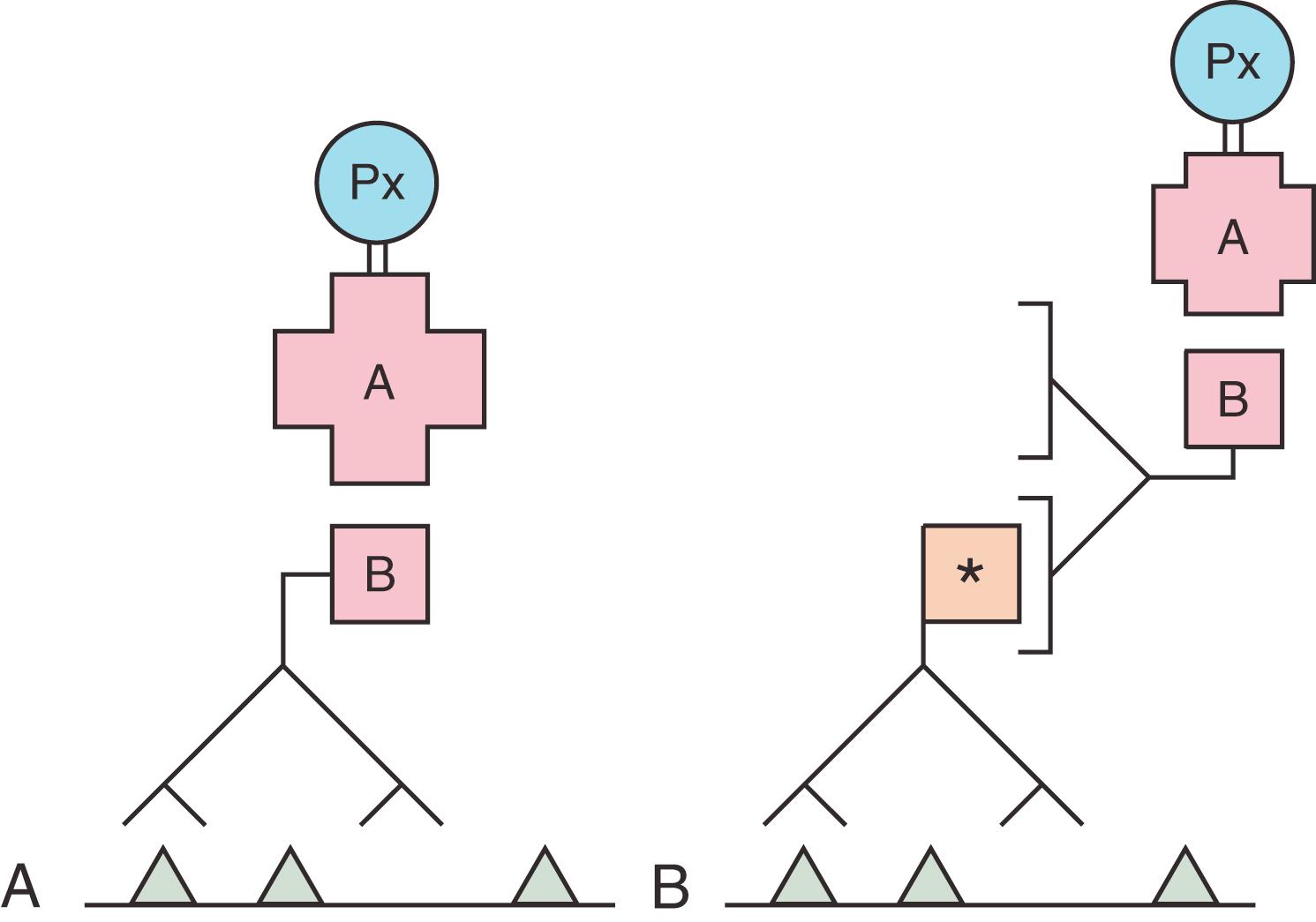
Two significant disadvantages exist. First, different batches of biotin and avidin have differing affinities for one other, which affects the sensitivity and reproducibility of the procedure. Second, some tissues contain significant amounts of endogenous biotin that may bind the avidin-peroxidase complex directly, thus producing nonspecific (false-positive) background. This effect can be eliminated by suitable blocking techniques, described in the following paragraphs.
Hsu and colleagues , developed a further modification of the biotin-avidin system that greatly enhanced its sensitivity ( Fig. 1.9 ). The ABC procedure serves to localize several molecules of HRP at the site of the antigen. Binding to endogenous biotin remains a problem, especially when testing liver, kidney, thyroid, and brain tissues.
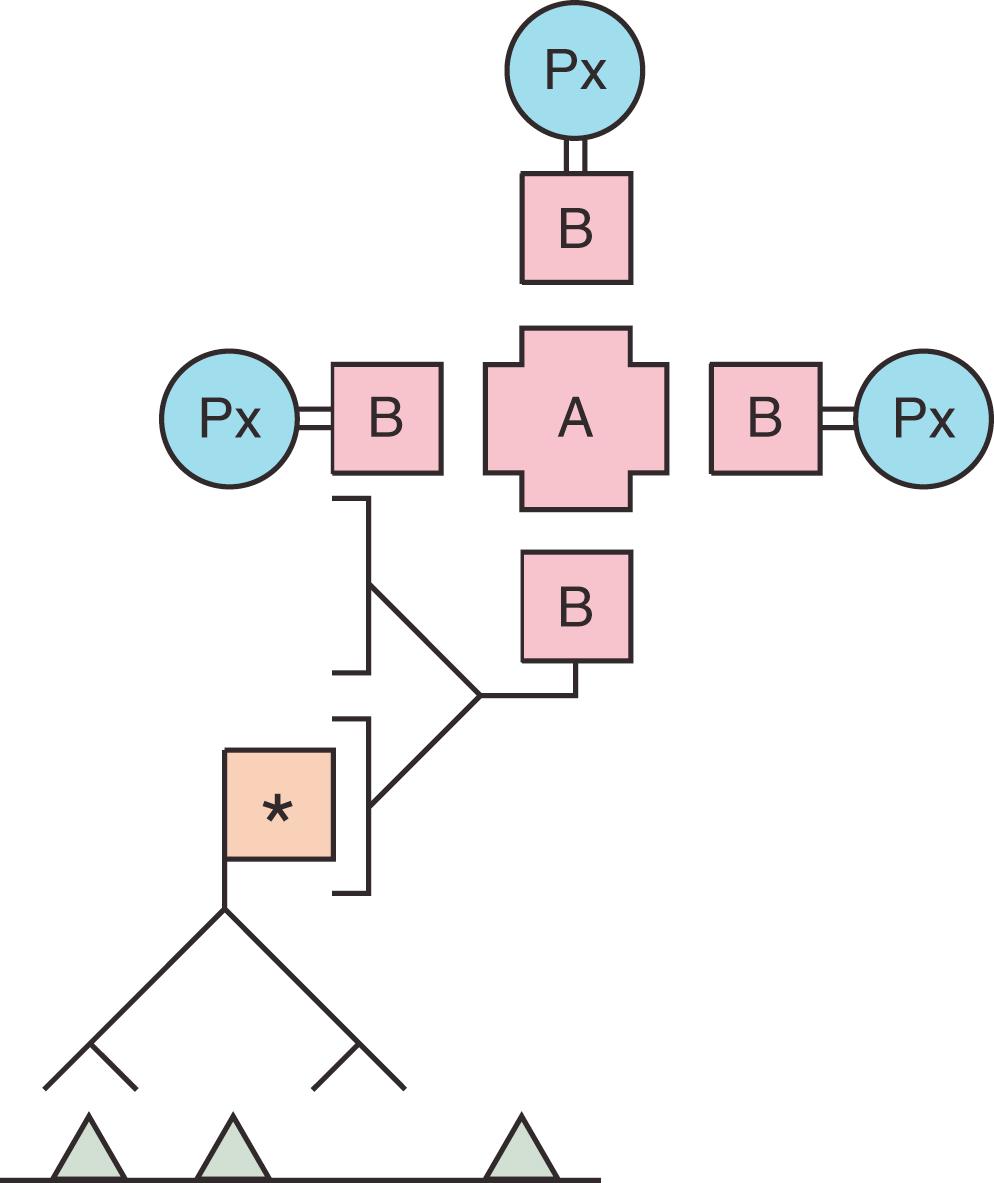
The B-SA method overcomes several of the problems associated with the ABC systems by substituting streptavidin for avidin and directly conjugating the streptavidin to the enzyme molecule. Streptavidin, a tetrameric 60-kDa avidin analog isolated from the bacterium Streptomyces avidinii, is capable of binding biotin with a very high affinity—approximately 10 times higher than that of most antibodies for their antigens. The use of streptavidin is preferred to avidin for several reasons:
Streptavidin contains no carbohydrates, which if present can bind nonspecifically to lectin-like substances found in normal tissue from kidney, liver, brain, and mast cells.
The isoelectric point of streptavidin is close to neutrality, whereas avidin has an isoelectric point of 10; thus, streptavidin conjugates exhibit less nonspecific electrostatic binding than avidin conjugates.
Because the enzyme is directly conjugated to streptavidin in the B-SA system, it is a highly stable reagent that can be diluted and stored for long periods in a “ready-to-use” (RTU) form. Secondary and labeling reagents based on these principles are available commercially that can provide substantial increases in sensitivity and also allow for increased dilution of expensive primary antibodies. Either peroxidase or alkaline phosphatase may be used as the enzyme label.
Increasingly, pathologists are seeking to demonstrate more than one antigen in a single tissue section (slide). The reasons for this approach are manifold: first, it reduces the number of slides tested, which makes the most efficient use of tissue biopsies that are progressively smaller in size, including fine needle aspirates (FNAs); and second, it facilitates interpretation of complex patterns of IR in mixed cell populations. Many automated platforms (discussed later) now provide the capability for multiplex testing, thereby rendering this approach more useful and more widely available.
Double-labeling antibody tests must produce contrasting colors to be effective in routine pathology. The simplest way to accomplish this has been to use a second enzymatic label, alkaline phosphatase, which has its own distinct family of chromogens (this approach is discussed and illustrated later). Many commercial suppliers now offer polyvalent detection systems that facilitate the detection of primary antibodies from two or more different species. Initially, double-labeling tests—or those with greater multiples, so-called “multiplex tests”—traditionally were performed sequentially, but recently the use of these newer approaches has allowed for simultaneous detection, decreasing run-time. Some manufacturers provide primary and secondary reagents in “cocktails” of antibodies, typically raised in different species (e.g., mouse and rabbit monoclonal antibodies) to avoid troublesome cross-reactions. Each component of any double labeling or multiplex tests must be separately validated for performance. Multiplex tests are discussed more extensively later in this chapter.
Alkaline phosphatase–labeled reagents may be introduced in several ways, essentially paralleling those methods used with HRP. Ongoing improvements in polymer-based methods (discussed in the following section) are so dramatic that it appears likely that these methods will supersede PAP and B-SA methods and double labeling tests, as the primary method. A brief description of special alkaline phosphatase applications follows as the basis for working with this useful method.
The principles of the alkaline phosphatase/anti-alkaline phosphatase (APAAP) technique are the same as those described for the PAP method ( Fig. 1.10 ). As with PAP, the APAAP method has largely been replaced by new polymer-based systems, and APAAP reagent is not widely available today. The method is included here for historic and research interest.
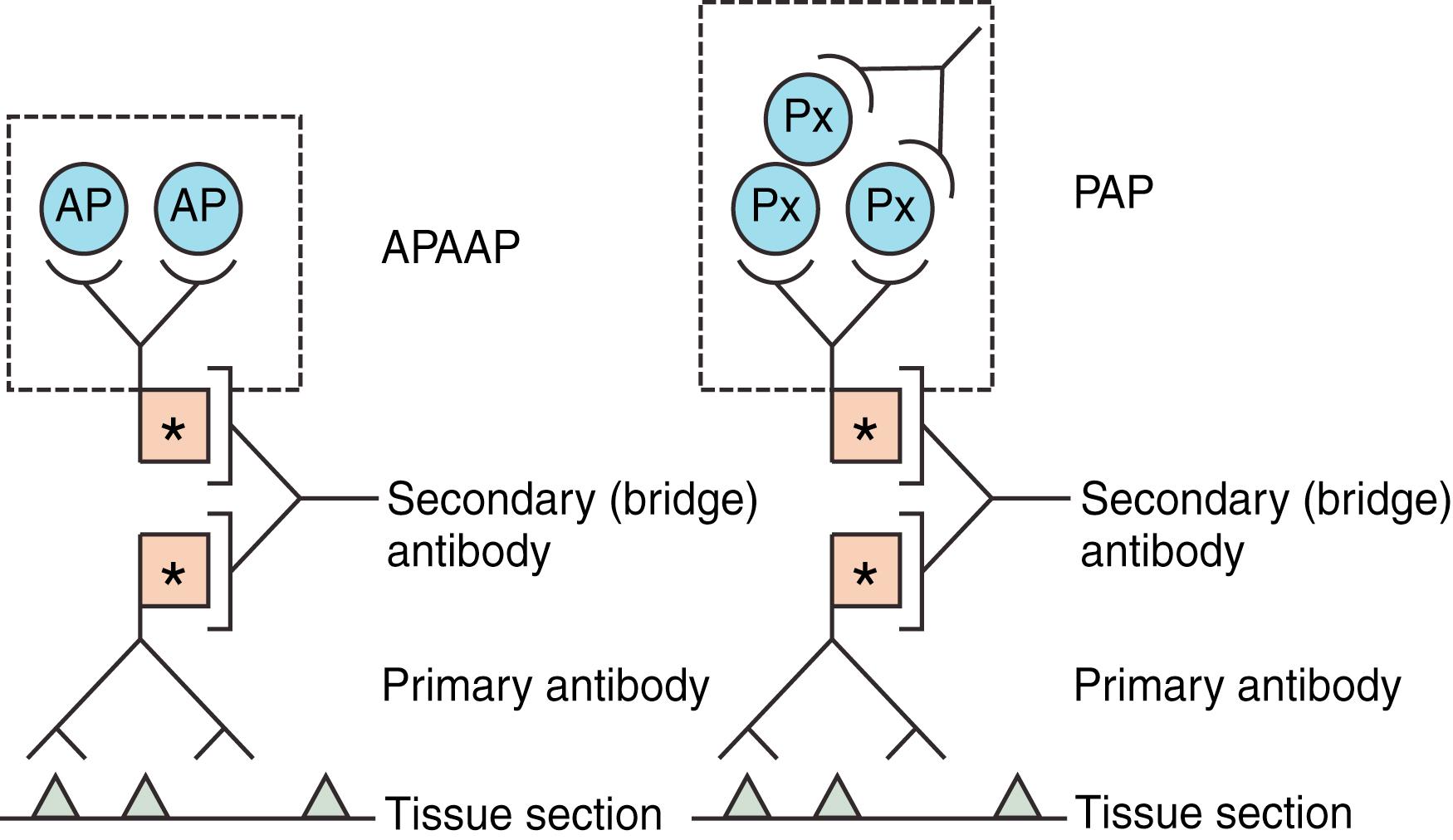
Alkaline phosphatase labeling is not only useful as a second, “dual” test, but it also may be preferred for tissues rich in endogenous peroxidase, such as bone marrow or lymphoid tissue that contains infiltrating myeloid cells, particularly with frozen sections. Because complete blocking of endogenous peroxidase in blood and bone marrow smears may be difficult and because blocking procedures may denature some antigenic determinants, alkaline phosphatase–based methods have proved useful in testing bone marrow. The study by Erber and McLachlan provides an excellent resource for those wishing to adopt this method.
For double-labeling IHC tests, it is convenient to use an alkaline phosphatase method in conjunction with an immunoperoxidase. The use of alkaline phosphatase as the second label has the advantage of avoiding the cross-reactivity that can occur when two immunoperoxidase procedures are used together (see later discussion). In addition, a simultaneous double immunolabeling procedure may be performed by using heterospecific antibodies, such as polyclonal and monoclonal antibodies, or mouse and rabbit monoclonals as the two primary antibodies under investigation (see Fig. 1.10 ). We will discuss this procedure in the context of cocktail methods. Sequential double-labeling IHC testing with the alkaline phosphatase method may also produce excellent contrasting colors by using Fast Red and Fast Blue substrates. In sequential double-labeling IHC tests, care must be taken to avoid mixed-color reactivity (i.e., having the initial red color change to purple); to this end, the weaker labeling antigen is usually identified first, and the second label applied may be developed for a shorter time (10 to 15 minutes, monitored by microscopy if possible). These general principles apply equally to double labeling IHC tests with polymer-based systems, discussed in the next section. In some cases, the bright red color produced by alkaline phosphatase substrates (Fast Red or New Fuchsin) may provide more distinct reactivity than the conventional peroxidase chromogens. On the other hand, some alkaline phosphatase substrates are not as stable as HRP substrates (e.g., DAB) and care must be taken when de-hydrating and coverslipping the slides after testing.
Most automated platforms now offer reagents and protocols for double or multiplex testing based on the polymer-type labels instead of PAP methods. With these automated approaches, the protocols should be followed exactly and only modified as necessary to obtain results with new antibody pairings, whereupon careful re-validation is then required.
The demand for more sensitive, more reliable, and simpler methods for IHC continues to escalate. Traditional multistep detection systems have several drawbacks: these include complex, time-consuming protocols; difficulties in standardization; and difficulties with sensitivity and ability to demonstrate hard-to-detect antigens. In practice, the reduction of the number of steps has, unfortunately, always been accompanied by a reduction in sensitivity. Approaches such as catalyzed reporter deposition or tyramine signal amplification (TSA), immuno-polymerase chain reaction (immuno-PCR), and end-product amplification have improved sensitivity; however, these techniques are accompanied by more complicated protocols with longer assay times, nonspecific background, and, often, poor reproducibility.
The development of polymer-based amplification methods has circumvented some of these issues. These methods use linking antibodies and marker enzymes attached to a backbone of synthetic polymers or to polymerized proteins ( Fig. 1.11A and B ). The natural or synthetic polymers increase the number of enzymes or ligands that are coupled to the linking antibodies. Examples of such carriers include dextran, polypeptides, dendrimers, and DNA branches. The trend is also to manufacture polymers of smaller overall molecular size, often called micropolymers, to reduce the possibility of steric interference. One big advantage of these polymer-based detection systems is that they avoid the use of biotinylated secondary antibody. Blocking of endogenous biotin is therefore not required, and the “false-positive” binding because of endogenous biotin is eliminated.
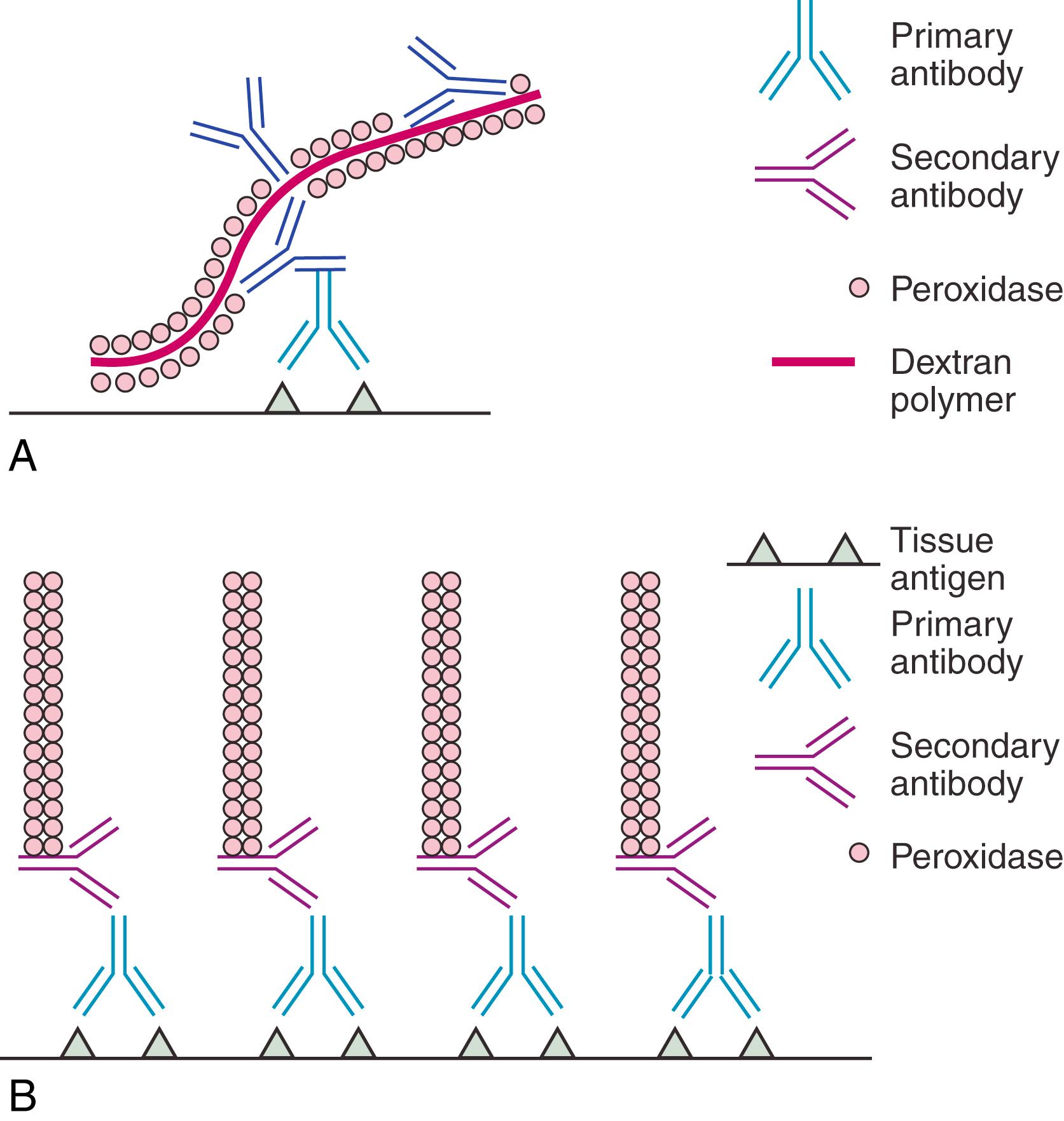
In practical terms, these advances have been greatly facilitated by automation, and polymer-based detection systems are now widely available for automated platforms. This outcome is consistent with the overall philosophy that, all other things being equal, simple techniques are better than complicated ones (see Fig. 1.11A and B ). Again, it must be emphasized that in the purchase and use of such methods that the instructions provided by the manufacturer must be followed rigorously. Departure from the provided protocol invalidates any implied performance warranty and may lead to false-positive or false-negative results or to slides that cannot be interpreted. As will be described later, the resulting colored products of some multiplex tests cannot be reliably separated by the naked eye and therefore require the use of digital images and sophisticated software for proper interpretation.
As with IHC labeling methods in general, polymer-based systems may be one-step direct or multistep methods. The enhanced polymer one-step (EPOS) detection system (Agilent Technologies-Dako Pathology) was introduced in 1993 by Bisgaard. In this system, the monoclonal primary antibody and HRP are covalently bound to an inert, high-molecular-weight dextran polymer. This technique offers the advantage of combining the link antibody step and the detection complex incubation step into a single step, giving a more rapid testing protocol. However, use of this system is restricted by limited availability of labeled primary antibodies. The one-step method may be performed on paraffin-embedded tissue sections, archival frozen tissues, and intraoperative frozen sections to yield sensitive and reproducible results. Turnaround time can be reduced to approximately 1 hour for routinely processed paraffin-embedded material and to less than 7 minutes for frozen-section material.
Today, two-step indirect polymer reagents are available from many commercial vendors. In general, reagents and protocols are available both for manual use and for automated platforms, and the principle is similar in all: the tissue is first incubated with the primary antibody and is then incubated with a polymeric conjugate in sequential steps. The polymeric conjugate may be relatively large, with as many as 100 peroxidase enzyme molecules and as many as 20 secondary antibody molecules (e.g., goat anti-mouse or goat anti-rabbit) bound to the polymer backbone. As noted, the trend is progressing toward more compact polymers. Because it is a two-step process, this method offers the laboratory the flexibility of choosing different primary antibodies, which the concentration and incubation times of which may be individually optimized.
Today, these polymer-based reagents continue to improve and offer many advantages to previous methods. Higher sensitivity allows detection of minute amounts of antigen, increased dilution of the primary antibody, and absence of false-positive background as a result of endogenous biotin. In addition, these reagents are stable and offer robust, reproducible protocols, particularly in an automated environment. Polymer-based methods also may be adapted to rapid performance for frozen sections for assessing margins (e.g., in Mohs surgery) and micrometastases, as well as to signal amplification for chromogenic in situ hybridization (CISH) with an increase in sensitivity and shorter assay times.
Successful application of any ultrasensitive detection system increases the likelihood that it may be necessary to re-titrate primary antibodies to a higher working dilution to avoid nonspecific background. , , Polymer-based methods also lend themselves well to double-labeling and multiplex testing, which is discussed later.
Based on the principle of enzyme amplification for immunoassays adopted in the 1980s, Bobrow and colleagues , developed a catalyzed reporter deposition technique (CARD) to achieve amplified signal for solid-phase immunoassay systems and membrane immunoassays. In this method, signal amplification is based on biotinylated tyramine (tyramide) deposition through free radical formation, which is catalyzed by the oxidizing action of HRP. It is postulated that radicalized biotinylated tyramine covalently attaches to electron-rich moieties—tyrosine, phenylalanine, tryptophan, and so on—resulting in aggregation of additional biotinylated molecules at the site of antigen-antibody reaction (i.e., amplification of the signal; Fig. 1.12 ).
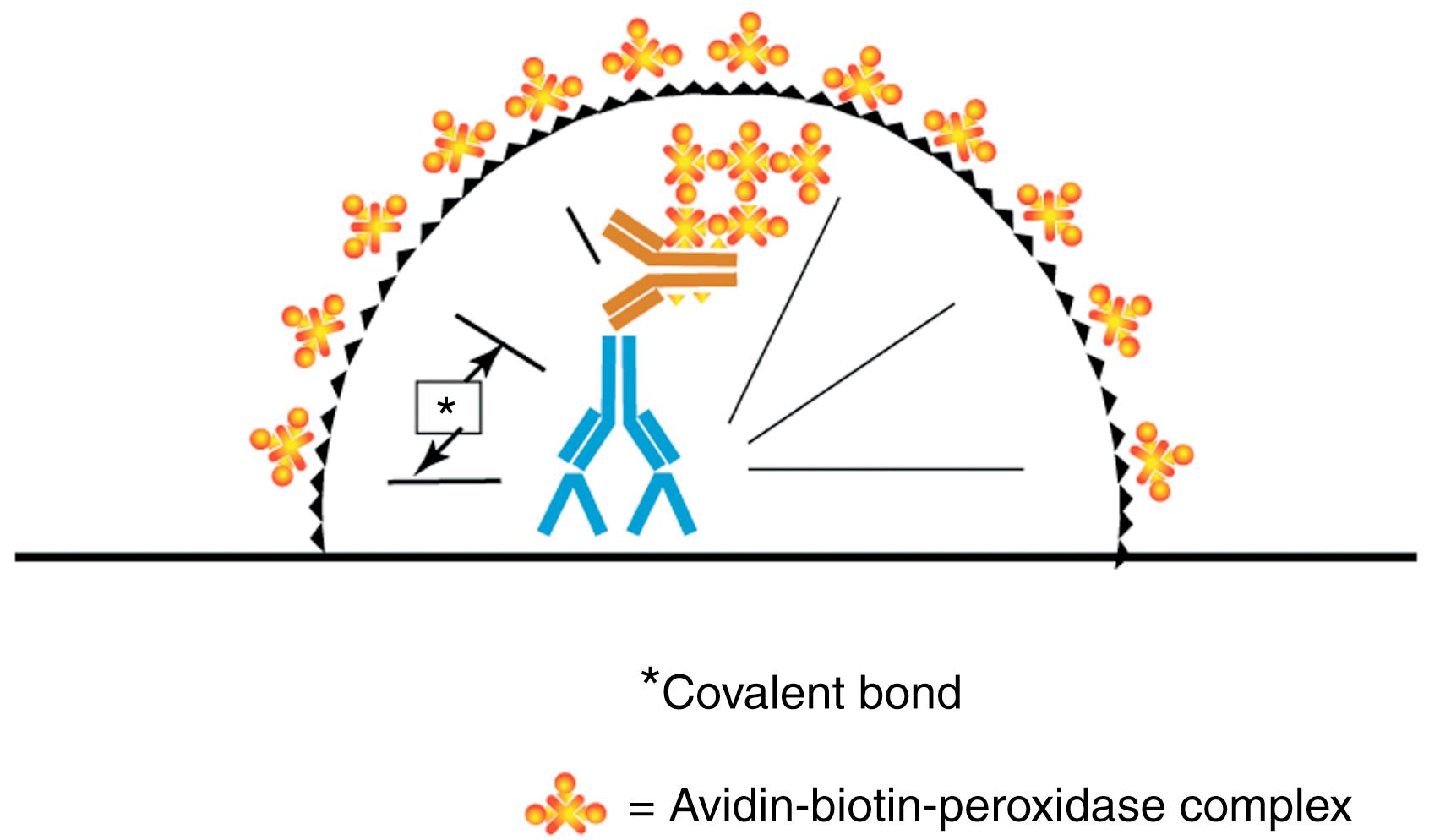
So-called TSA for IHC has achieved IR for some hard-to-detect antigens in archival paraffin-embedded tissue sections. Several commercial TSA reagents are available in kit form. With use of these TSA kits, additional steps are performed after use of a regular HRP-conjugated detection system; namely, incubating the slides with a biotinylated tyramine reagent, washing them thoroughly, and then incubating the slides with more HRP-conjugated streptavidin. Finally, a chromogen is used—for example, DAB or amino-ethylcarbazole (AEC)—to visualize the amplified signal in the tissue sections.
Although the TSA method has achieved satisfactory results in terms of significantly increasing intensity of IHC and in situ hybridization (ISH), it has not been widely applied in diagnostic pathology for several reasons: (1) additional steps make the method more time consuming; (2) nonspecific background reactivity may increase as the signal increases; (3) reproducibility is more difficult to achieve; (4) second-generation polymer-based methods are simpler and give high sensitivity sufficient for many requirements; and (5) automated platforms provide the possibility of much more reproducible performance of this powerful method, achieving high sensitivity and short assay time.
A variety of other methods exist that allow for labeling of antigen (protein) in tissue sections. Most are restricted to research applications, but the pace is such that further development and increased availability of new, more sensitive methods will continue. Two approaches are described briefly for specific research advantages.
Protein A, derived from Staphylococcus, has the remarkable ability to bind with the constant (Fc) portion of Ig molecules from several different species. The only absolute requirement is that the primary antibody binds with protein A and that most IgG molecules bind protein A, although affinity varies among different IgG subclasses and among different species ( Figs. 1.13 and 1.14 ). Protein A methods generally do not match the sensitivity of corresponding streptavidin or polymer-based techniques, but they have advantages that may warrant their use in specific circumstances.
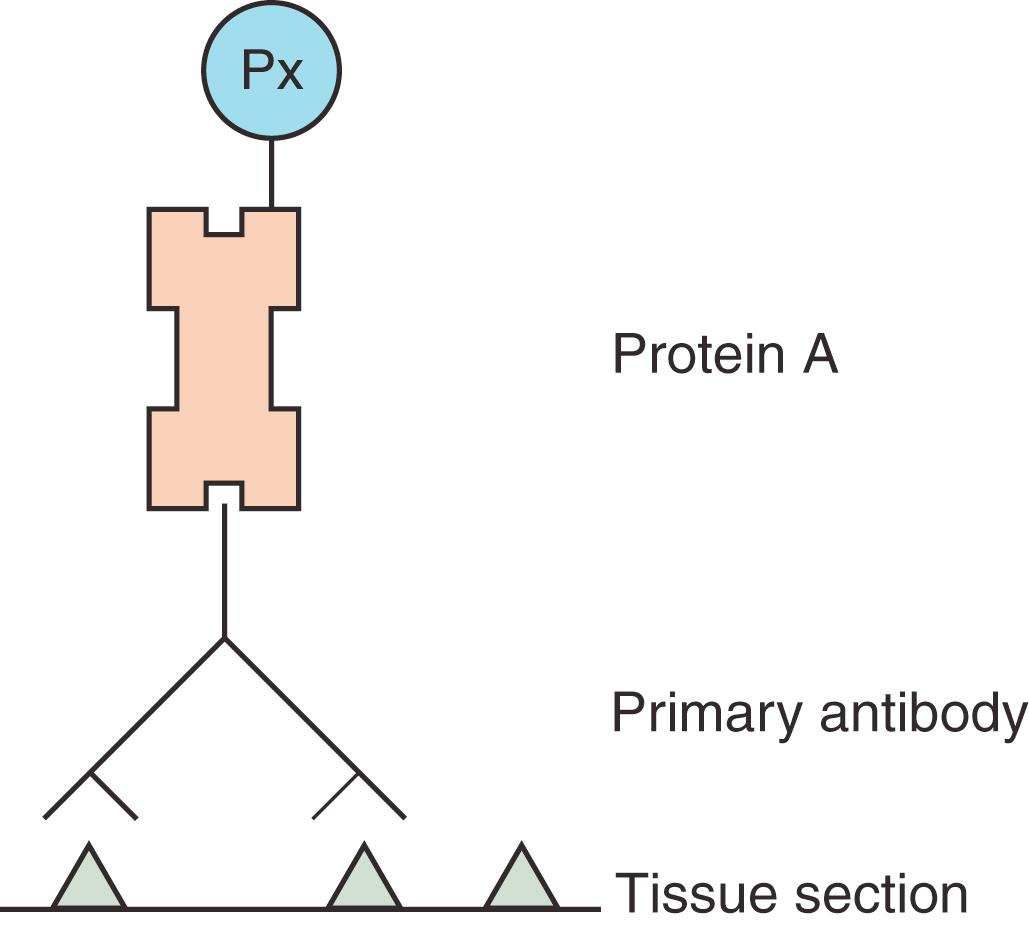
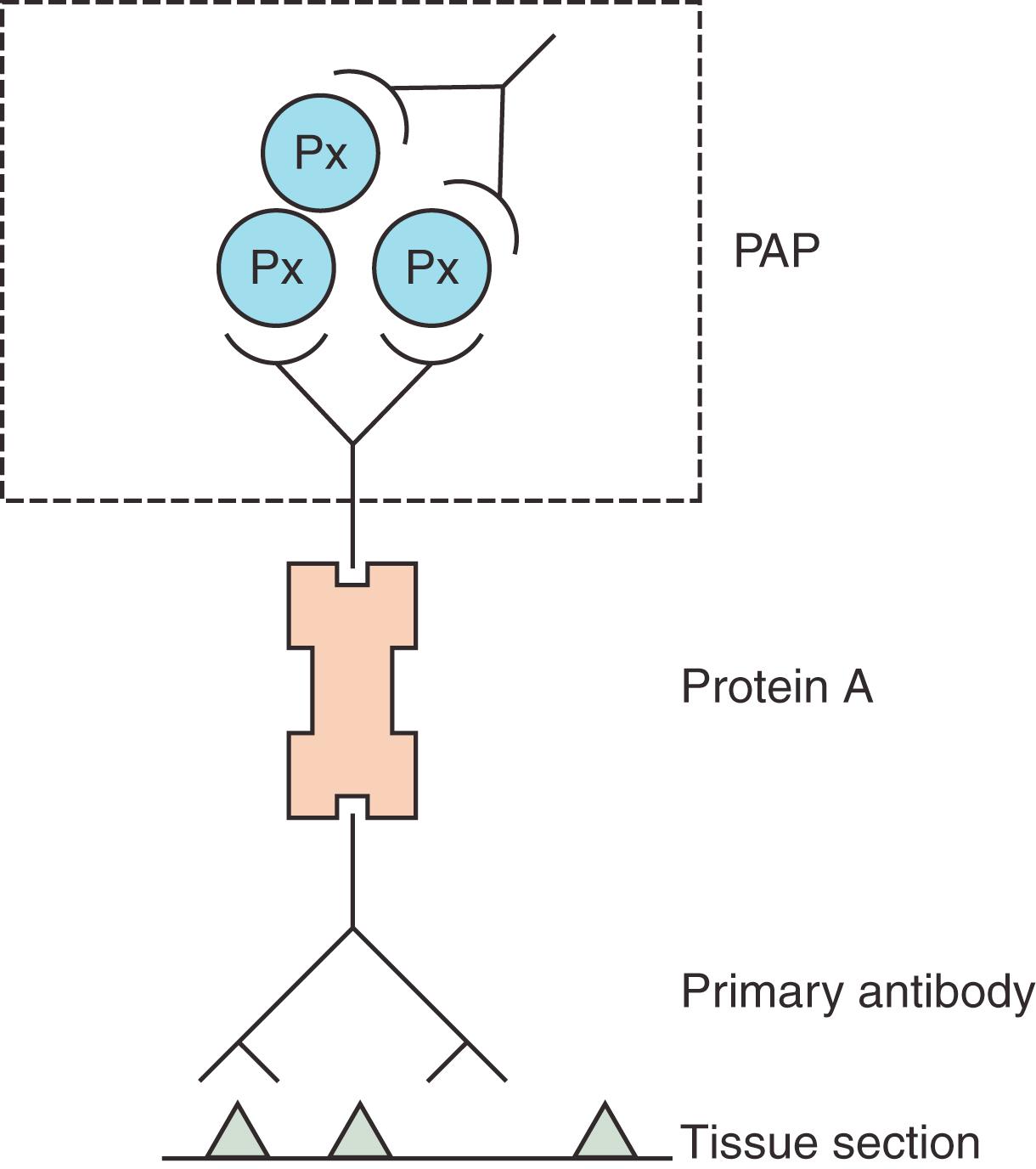
The enzyme-labeled antigen method ( Fig. 1.15 ) was devised as perhaps the ultimate in specificity among immunoperoxidase techniques. Only one antibody is used, and the method exploits the fact that an antibody molecule possesses two valences, one of which may be bound to the antigen under study, with the second valency left free to bind with additional molecules of antigen added subsequently. The additional antigen is presented in a form that is directly conjugated with HRP; thus, this is considered a labeled antigen procedure.
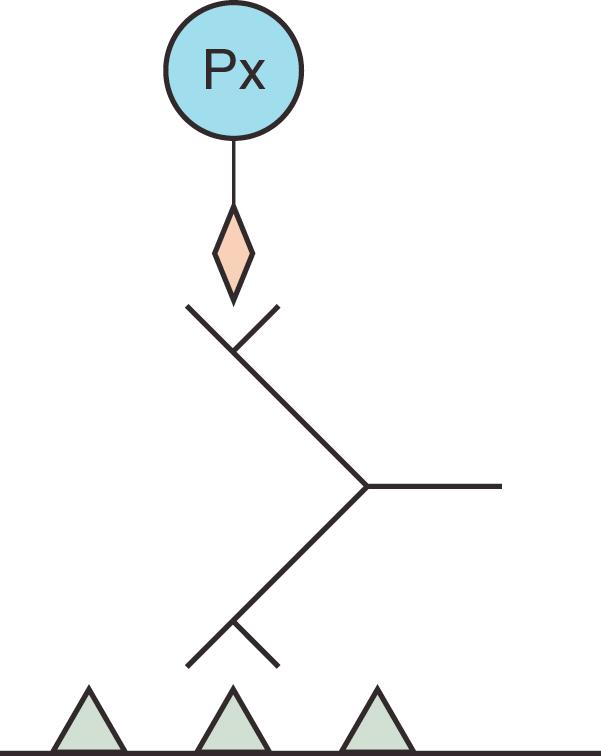
The primary antibody is generally used at a relatively high concentration; therefore, this method is not economical in its use of the primary antibody. However, one major advantage is that the primary antibody need not be particularly pure, because antibodies of irrelevant specificity will not be detected by this technique even if they bind to the tissue section; lacking specificity for the target antigen, they will not bind the same antigen presented in the antigen-peroxidase conjugate; thus, they will not be visualized. This method has proved particularly suitable for high-specificity and double-antibody techniques whereby the goal is to detect two antigens simultaneously within the same section ( Fig. 1.16 ) by using two labeled antigens (e.g., κ-peroxidase and α–alkaline phosphatase) together.
![Fig. 1.16, Labeled antigen double stain. Two different antibodies recognize their respective antigens in the tissue section and subsequently bind only the corresponding labeled antigen (labeled with peroxidase [Px] or alkaline phosphatase [AP] ). Fig. 1.16, Labeled antigen double stain. Two different antibodies recognize their respective antigens in the tissue section and subsequently bind only the corresponding labeled antigen (labeled with peroxidase [Px] or alkaline phosphatase [AP] ).](https://storage.googleapis.com/dl.dentistrykey.com/clinical/TechniquesofImmunohistochemistryPrinciplesPitfallsandStandardization/15_3s20B9780323721721000010.jpg)
The optimal dilution for an antibody in IHC is defined as the dilution at which the greatest contrast is achieved between the desired (specific) IR and any unwanted (nonspecific) background “noise.” Selection is subjective and is based not simply on the greatest intensity but rather on the greatest useful contrast. Titration is relatively straightforward in the direct method, with only a single antibody ( Table 1.1 ). In two-layer methods, exemplified by the indirect and polymer-based labels, each of the separate immune reagents must be applied at optimal dilution. In addition, the dilutions of the primary and secondary labeled antibodies are interdependent in terms of contrast developed by the procedure as a whole. This fact necessitates comparison of the results obtained by using several dilutions of the labeling reagent (secondary antibody) with several different dilutions of the primary antibody, and the comparison is achieved by checkerboard titration ( Table 1.2 ). Multistep procedures require more complex checkerboard titrations of each of these separate steps. The reader is invited to refer to previous editions of this book or the 2006 work of Taylor and Cote, Immunomicroscopy: A Diagnostic Tool for the Surgical Pathologist, for further details of more complex checkerboard titrations used in research.
| Serial Dilutions of Primary Antibody | ||||||
|---|---|---|---|---|---|---|
| 1/5 | 1/20 | 1/80 | 1/320 | 1/1280 | 1/2560 | |
| Intensity of reactivity a | ||||||
| Unwanted background b | ++ | + | ± | ± | ± | ± |
| Specific antigens c | +++ | ++++ | ++++ | +++ | ++ | + |
a Intensity of reactivity scored on a semiquantitative scale from 0 to ++++; ± indicates faint positivity of uncertain significance.
b Unwanted background may result from several different mechanisms.
c Intensity of reactivity of specific antigen (e.g., with titration of anti-κ antibody, specific immunoreactivity would be present in plasma cells).
| Dilutions of Primary Antibody | |||||||
|---|---|---|---|---|---|---|---|
| 1/5 | 1/20 | 1/80 | 1/320 | 1/1280 | Negative Control a | ||
| Dilutions of secondary antibody (conjugate) | 1/10 | Slide 1 | Slide 2 | Slide 3 | Slide 4 | Slide 5 | Slide 16 |
| +++ b | ++++ | +++ | ++ | + | ± | ||
| (++) | (++) | (++) | (++) | (++) | (++) | ||
| 1/40 | Slide 6 | Slide 7 | Slide 8 | Slide 9 | Slide 10 | Slide 17 | |
| +++ | +++ | ++++ | ++++ | ++ | − | ||
| (+) | (+) | (+) | (±) | (±) | (±) | ||
| 1/160 | Slide 11 | Slide 12 | Slide 13 | Slide 14 | Slide 15 | Slide 18 | |
| ++ | ++ | + | ± | ± | − | ||
| (+) | (±) | (±) | (−) | (−) | (−) | ||
a Negative control (omit primary antibody, replace with pre-immune serum or serum with irrelevant specificity; see negative controls).
b Intensity of specific reactivity is indicated on a scale of 0 to ++++. Nonspecific background is given on the same scale but is shown in parentheses; for example, +++ (+) indicates strong specific immunoreactivity (+++) with moderate background (+).
Once optimal dilutions have been determined, the stock of undiluted reagent can be stored at 4 ° C or can be divided into convenient aliquots for the preparation of working dilutions immediately before use, and then frozen. The reagent’s product data sheet should provide storage instructions. In general, it is not wise to store reagents in a highly diluted form unless additional protein (e.g., bovine serum albumin) or other stabilizers are added to conserve activity, because reactivity may decline unpredictably. The ability to obtain the stability of highly diluted reagents is evidenced by the availability of commercial immunolabeling kits that contain prediluted RTU reagents ( Table 1.3 ). These RTU IHC reagents, including concentrated primary antibodies, come labeled with what’s called an “Expiration Date,” which is a controversial term for many pathologists and scientists. The reality is that these reagents do not expire when the so-called expiration date arrives, and this has been documented in several studies. However, manufactures are required to provide an “Expiration Date” for IHC reagents, and users may find themselves “locked-out” from using these reagents when they have been registered with the automated instrument’s software even though reagent remains. Given the fact that many laboratories today have shrinking budgets, especially in light of the financial impact of the COVID-19 pandemic, and that many reimbursements for IHC testing are decreasing, this issue needs to be re-evaluated by the agencies that regulate reagents for clinical laboratory testing. One must note that an IHC test is validated every time that it is run with the positive control. At a minimum, exceptions should be granted for antibodies that are rarely used or are no longer produced commercially. Perhaps instead of an expiration date, manufactures could supply a “stability guaranteed” date to provide laboratories more flexibility without sacrificing patient care.
| Home Brew | Ready-to-Use |
|---|---|
| Select primary antibodies and purchase Purchase suitable labeling antibodies Purchase chromogens, etc. |
Purchase kit that includes all reagents, matched and tested for performance |
| Titrate primary antibodies Identify appropriate labeling method Select chromogen Establish time and concentration |
Prediluted primary antibodies included Includes labeling method, pretested Includes chromogen Includes protocol |
| Obtain serial dilutions of labeling reagent Establish incubation times |
Prediluted reagents included Recommended times provided |
| Establish protocol Select controls |
Protocol included Recommended controls |
A principal reason for the use of reagents freshly prepared from aliquots is the need to avoid repeated sampling of a single reagent tube or bottle, as with a calibrated pipette, because this practice almost invariably results in bacterial contamination and loss of reactivity that is both unpredictable and aggravating. Here the “pure” scientists might learn a lesson from their often maligned cousins in the commercial sector, who have, to a large extent, overcome the contamination problem by providing diluted reagents in sealed dropper bottles so that the reagent can be dropped directly from the reagent bottle. Taylor and colleagues have unashamedly borrowed this technique in our laboratory, and whenever we make up new dilutions of reagents for use over a period of several days, we use these small plastic dropper bottles.
In general, two approaches may be used to establish a new IHC test in the laboratory or, in fact, to perform IHC tests in general. The first is to work from basic principles, purchasing all reagents separately and building the protocol “in-house.” This approach, formerly referred to as home brewing, and now considered a “laboratory-developed test” (LDT), requires extensive validation of reagents and protocol plus an obvious ability to perform detailed checkerboard titrations reliably. The second approach is to purchase all of the IHC test components in an optimized kit, sometimes the US Food and Drug Administration (FDA)-approved for specific IHC platforms, the so-called RTU kit. Validation of the performance of the overall kit against appropriate controls (see later) is still required, but the need to perform multiple complex titrations is obviated (see Table 1.3 ).
Both of these approaches have their different advantages and disadvantages, as summarized in Table 1.3 . If performance is not adequate, the “home brew” or LDT has the advantage of greater flexibility in choice of reagents and concentrations, but it requires in-house expertise to make such adjustments and to validate performance. In practice, the need for such adjustments is mostly a result of different, often inadequate methods of sample preparation. In general, it is better to correct poor or variable sample preparation than to try to compensate for such by resorting to overly vigorous retrieval or increased concentrations of antibodies or labels.
Note that the use of RTUs does enforce some uniformity upon different laboratories, which is a good thing, as discussed later. Also, automated platforms usually are accompanied by a menu of RTU reagents optimized for each specific platform. As noted elsewhere, deviation from the recommended reagents or protocol places the full burden of validation on the laboratory. Validation of IHC tests can be made using histologic and cytologic morphology, and results from other types of laboratory testing (e.g., flow cytometry, cytogenetics, next-generation sequencing [NGS], mRNA expression, and microbiology). The College of American Pathologists (CAP) Pathology and Laboratory Quality Center published an extensive review on the principles of analytical validation in 2014.
Standardization to achieve reproducibility of results within a lab and among different labs has become increasingly important as IHC has been adapted to tests for prognostic (e.g., ER, PR, HER2, and Ki-67) and predictive markers (e.g., ER, PR, HER2, CD20, PD-L1). Such tests require some degree of quantification, and greater stringency of performance is therefore necessary. , As defined by the CAP, QC is “the aggregate of processes and techniques so derived to detect, reduce and correct deficiencies in an analytical process.” It is an integral component of a laboratory’s quality assurance program, focusing mainly on procedural and technical aspects of the test under question. As it pertains to IHC, QC standards should address and define each step of the “Total Test” ( Table 1.4 ), including tissue procurement, fixation, processing, sectioning, testing, and, finally, the interpretation of controls and test specimen, and the reporting of the results.
| Elements of the Testing Process | Quality Assurance Issues | Responsibility |
|---|---|---|
| Clinical question, test selection | Indications for immunohistochemistry Selection of tests |
Surgical pathologist, sometimes the clinician |
| Specimen acquisition and management | Specimen collection, fixation, processing, and sectioning | Pathologist/technologist |
| Analytical issues | Qualifications of staff Intra-laboratory and inter-laboratory proficiency testing of procedures |
Pathologist/technologist |
| Results validation and reporting | Criteria for positivity/negativity in relation to controls Content and organization of report Turnaround time |
Pathologist/technologist |
| Interpretation, significance | Experience/qualifications of pathologist Proficiency testing of interpretational aspects Diagnostic and prognostic significance Appropriateness/correlation |
Surgical pathologist, clinician, or both |
As part of a laboratory’s QC program, all steps of the test should be described separately, and parameters of each step must be established and monitored to ensure consistency of performance and reproducibility of results. Daily records of control results are maintained and signed-off by the laboratory director or a designee, and corrective actions are undertaken and documented when results are unacceptable. In practice, the surgical pathology histology laboratory typically falls short of the ideal standards for IHC, especially regarding tissue preparation. In this section, we discuss QC issues as they pertain to the validation of antibodies and the use of controls. We also address measures that may be adopted to minimize variability that derives from inconsistent tissue preparation, including fixation.
Following the last edition of this book, the long-awaited guidelines of the Clinical and Laboratory Standards Institute (CLSI) have been published. This document is the most comprehensive treatise of quality assurance and performance aspects of IHC in existence, and it devotes 139 pages to the design and implementation of IHC assays. Every laboratory that performs IHC should have a copy on hand for reference and guidance.
The CLSI guidelines incorporate many of the tenets put forward previously in the “Total Test approach,” borrowed, in essence, from rigorous clinical laboratory practice. Sample preparation, validation of all reagents and procedures, and proper use of controls are given particular emphasis. This chapter presents the essentials; for further detail, the text Immunomicroscopy or the CLSI guidelines should be consulted directly.
Become a Clinical Tree membership for Full access and enjoy Unlimited articles
If you are a member. Log in here